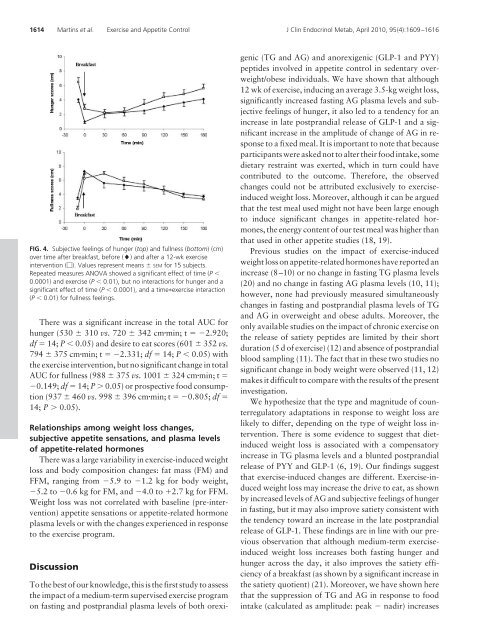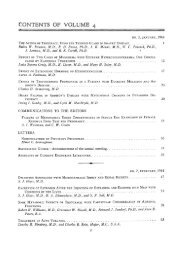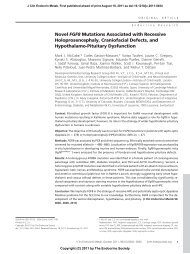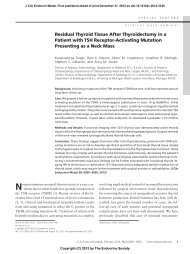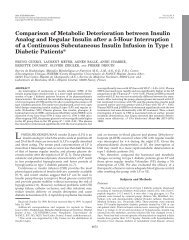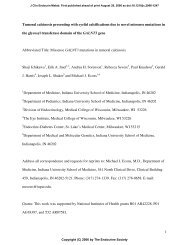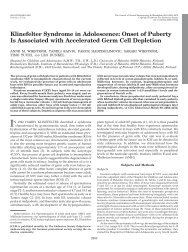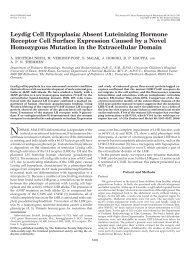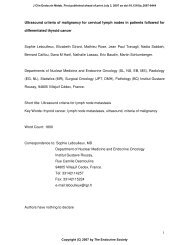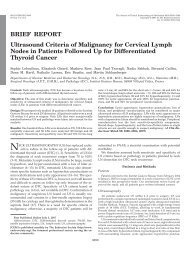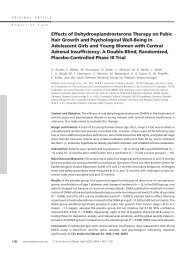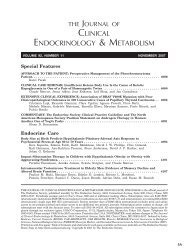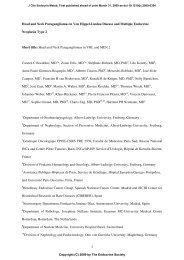The Effects Of Exercise-Induced Weight Loss On - The Journal of ...
The Effects Of Exercise-Induced Weight Loss On - The Journal of ...
The Effects Of Exercise-Induced Weight Loss On - The Journal of ...
You also want an ePaper? Increase the reach of your titles
YUMPU automatically turns print PDFs into web optimized ePapers that Google loves.
1614 Martins et al. <strong>Exercise</strong> and Appetite Control J Clin Endocrinol Metab, April 2010, 95(4):1609–1616<br />
FIG. 4. Subjective feelings <strong>of</strong> hunger (top) and fullness (bottom) (cm)<br />
over time after breakfast, before (�) and after a 12-wk exercise<br />
intervention (�). Values represent means � SEM for 15 subjects.<br />
Repeated measures ANOVA showed a significant effect <strong>of</strong> time (P �<br />
0.0001) and exercise (P � 0.01), but no interactions for hunger and a<br />
significant effect <strong>of</strong> time (P � 0.0001), and a time�exercise interaction<br />
(P � 0.01) for fullness feelings.<br />
<strong>The</strong>re was a significant increase in the total AUC for<br />
hunger (530 � 310 vs. 720 � 342 cm�min; t ��2.920;<br />
df � 14; P � 0.05) and desire to eat scores (601 � 352 vs.<br />
794 � 375 cm�min; t ��2.331; df � 14; P � 0.05) with<br />
the exercise intervention, but no significant change in total<br />
AUC for fullness (988 � 375 vs. 1001 � 324 cm�min; t �<br />
�0.149; df � 14; P � 0.05) or prospective food consumption<br />
(937 � 460 vs. 998 � 396 cm�min; t ��0.805; df �<br />
14; P � 0.05).<br />
Relationships among weight loss changes,<br />
subjective appetite sensations, and plasma levels<br />
<strong>of</strong> appetite-related hormones<br />
<strong>The</strong>re was a large variability in exercise-induced weight<br />
loss and body composition changes: fat mass (FM) and<br />
FFM, ranging from �5.9 to �1.2 kg for body weight,<br />
�5.2 to �0.6 kg for FM, and �4.0 to �2.7 kg for FFM.<br />
<strong>Weight</strong> loss was not correlated with baseline (pre-intervention)<br />
appetite sensations or appetite-related hormone<br />
plasma levels or with the changes experienced in response<br />
to the exercise program.<br />
Discussion<br />
To the best <strong>of</strong> our knowledge, this is the first study to assess<br />
the impact <strong>of</strong> a medium-term supervised exercise program<br />
on fasting and postprandial plasma levels <strong>of</strong> both orexi-<br />
genic (TG and AG) and anorexigenic (GLP-1 and PYY)<br />
peptides involved in appetite control in sedentary overweight/obese<br />
individuals. We have shown that although<br />
12 wk <strong>of</strong> exercise, inducing an average 3.5-kg weight loss,<br />
significantly increased fasting AG plasma levels and subjective<br />
feelings <strong>of</strong> hunger, it also led to a tendency for an<br />
increase in late postprandial release <strong>of</strong> GLP-1 and a significant<br />
increase in the amplitude <strong>of</strong> change <strong>of</strong> AG in response<br />
to a fixed meal. It is important to note that because<br />
participants were asked not to alter their food intake, some<br />
dietary restraint was exerted, which in turn could have<br />
contributed to the outcome. <strong>The</strong>refore, the observed<br />
changes could not be attributed exclusively to exerciseinduced<br />
weight loss. Moreover, although it can be argued<br />
that the test meal used might not have been large enough<br />
to induce significant changes in appetite-related hormones,<br />
the energy content <strong>of</strong> our test meal was higher than<br />
that used in other appetite studies (18, 19).<br />
Previous studies on the impact <strong>of</strong> exercise-induced<br />
weight loss on appetite-related hormones have reported an<br />
increase (8–10) or no change in fasting TG plasma levels<br />
(20) and no change in fasting AG plasma levels (10, 11);<br />
however, none had previously measured simultaneously<br />
changes in fasting and postprandial plasma levels <strong>of</strong> TG<br />
and AG in overweight and obese adults. Moreover, the<br />
only available studies on the impact <strong>of</strong> chronic exercise on<br />
the release <strong>of</strong> satiety peptides are limited by their short<br />
duration (5 d <strong>of</strong> exercise) (12) and absence <strong>of</strong> postprandial<br />
blood sampling (11). <strong>The</strong> fact that in these two studies no<br />
significant change in body weight were observed (11, 12)<br />
makes it difficult to compare with the results <strong>of</strong> the present<br />
investigation.<br />
We hypothesize that the type and magnitude <strong>of</strong> counterregulatory<br />
adaptations in response to weight loss are<br />
likely to differ, depending on the type <strong>of</strong> weight loss intervention.<br />
<strong>The</strong>re is some evidence to suggest that dietinduced<br />
weight loss is associated with a compensatory<br />
increase in TG plasma levels and a blunted postprandial<br />
release <strong>of</strong> PYY and GLP-1 (6, 19). Our findings suggest<br />
that exercise-induced changes are different. <strong>Exercise</strong>-induced<br />
weight loss may increase the drive to eat, as shown<br />
by increased levels <strong>of</strong> AG and subjective feelings <strong>of</strong> hunger<br />
in fasting, but it may also improve satiety consistent with<br />
the tendency toward an increase in the late postprandial<br />
release <strong>of</strong> GLP-1. <strong>The</strong>se findings are in line with our previous<br />
observation that although medium-term exerciseinduced<br />
weight loss increases both fasting hunger and<br />
hunger across the day, it also improves the satiety efficiency<br />
<strong>of</strong> a breakfast (as shown by a significant increase in<br />
the satiety quotient) (21). Moreover, we have shown here<br />
that the suppression <strong>of</strong> TG and AG in response to food<br />
intake (calculated as amplitude: peak � nadir) increases


